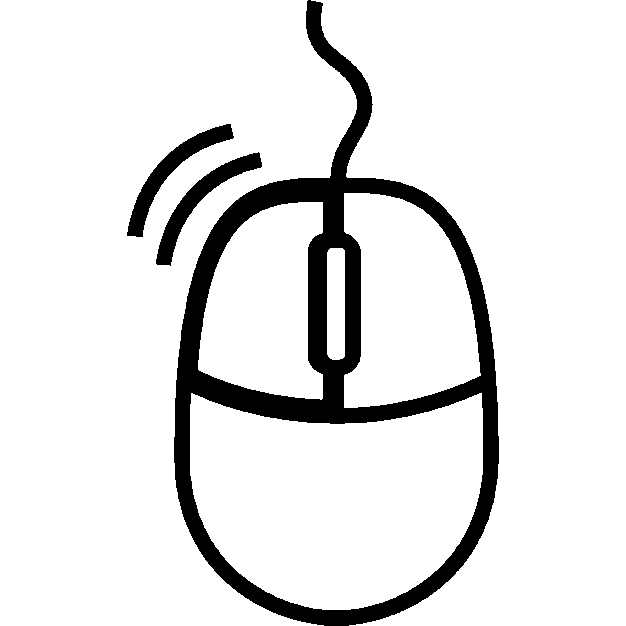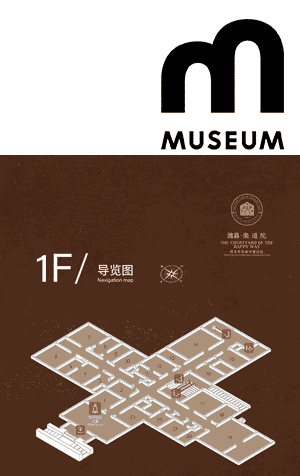
second level:
ground floor
(main entrance)...
ground floor
(main entrance)...
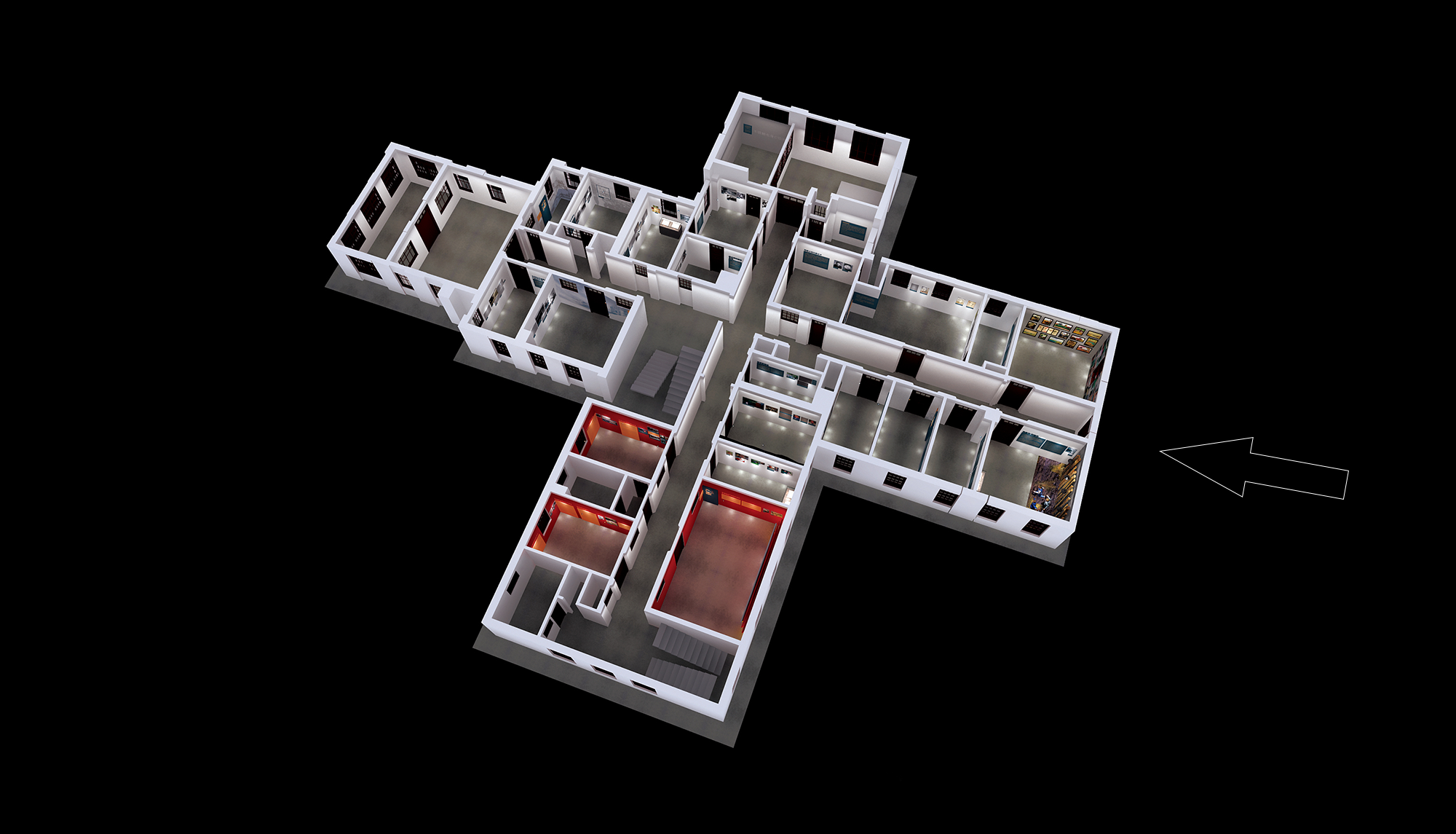






... written on the information boards :

... written on the informations boards are the translations of the Chinese texts pepared for the visitors of the museum by the Weifang Historians ... enjoy your visit.
THE WEDGED SCENERY
THE COURYARD OF THE HAPPY WAY
In the middle of the 19th century, the East-West civilization had a violent collision. With the modernization brought by the Industrial Revolution, the western powers opened the door of China. More and more Westerners started to step on the ancient land, and the church forces were not so far behind, and they tried to change the land in a way of spreading religions.
Weihsien (now Weifang), Shandong Province, was an ancient place with a long history. For the first time in that turbulent era, several foreigners bought land on the outskirts of the city and built a sermon station, which they called the Courtyard of the Happy Way. From conflict to integration, from prosperity to destruction, from saving lives and helping people to teaching and educating people ... these were what the wedged culture had brought to Weihsien in the more than 100 years since its establishment. Besides, it aroused people's awareness of looking at the world and quietly promoted the process of modernization.
A BIG CHANGE NEVER SEEN IN 3000 YEARS
In 1840, the sound of artillery from the Opium Wars shook the Forbidden City. Faced with “an unprecedented change in 3,000 years”, China that had long shut the door to the outside world was caught unprepared. The Cross came along with the warships, cannons and unequal treaties to China. With the slogan of “conquering China with the Cross”, a large number of Western missionaries swarmed to inland China.
AWAKENEND CHINA
The rulers of the Qing Dynasty, boasting of "the son of Heaven", overlooked their world and adhered to the feudal monarchy with a high degree of centralization. In the face of the western powers that came from afar, they were stubborn and old-fashioned and refused to open their eyes to the world until they were awakened and panicked by the rumbling of artillery.
The Forbidden City stands for the power center of the Qing Dynasty. Of its more than 70 palaces, large or small, and more than 8,000 houses, Hall of Supreme Harmony is the best to show the majesty of emperors. Being the largest in size and the highest in level, it represents the supreme imperial power and is a symbol of the feudal imperial system in China.
In 1792, the 57th year under the reign of Emperor Qianlong (1736 - 1796), the British government sent a mission headed by George McCartney to visit China with the purpose of celebrating the 80th birthday of the Emperor, and expected to get the approval of the Emperor to open the doors of China.
The first official contact between the tw countries, however, ended with an unpleasant result, and the Qing government, who thought China a great country, did not find a plot behind.
The Emperor Qianlong even gave a great reward to the 12-year old George Thomas Staunton, [ - please click on the blinking smiley !] the son of British deputy envoy George Leonard Staunton. Just over 40 years later, it was Thomas who incited the British Parliament to launch a war against China.
- please click on the blinking smiley !] the son of British deputy envoy George Leonard Staunton. Just over 40 years later, it was Thomas who incited the British Parliament to launch a war against China.
THE CROSS UNDER THE BAYONNET
After the Opium War, there was an upsurge in Western powers’ partition of China.
In politics, the Western powers set up “leased territories” and divided “spheres of influence”;
in economy, they exported their capital and products on a large scale, broke the original economic mode in China and rendered China a dumping market.
In the meantime, they conducted cultural aggression.
Lots of Western missionaries came to the urban and rural areas in China, built churches and preached, acting as the “tools to suppress the colony”.
After the Opium Wars, the Qing government allowed missionaries to preach in China. As a result, large and small churches, like bamboo shoots, appeared in China one after another.
Many of them are still preserved
A FAMOUS CITY OF ANCIENT BEIHAI
Weihsien, the old name of Weifang before Liberation, was the most prosperous city of ancient Donglai and the famous city of ancient Beihai. It was a vital place to link inland Shandong and the peninsula area. The convenient transportation promoted the cultural and economic prosperity. According to the historical records, during the period of Ming and Qing dynasties to the Republic of China, it was famous for "two hundred red furnaces, three thousand copper-doers, nine thousand needlewomen and one hundred thousand looms". And during the reign of Emperor Qianlong, there were the claims of "Suzhou in South and Weihsien in North "to describe their prosperity.
In the late Qing Dynasty, the Jiaozhou-Jinan Railway, which connected Qingdao and Jinan, passed through Weihsien. The opening of the railway placed Weihsien at a favorable position in its process of modernization. Perhaps, it was for this reason that Western missionaries "targeted" here, and then came the story of the Courtyard of the Happy Way.
THE MOST PROSPEROUS PLACE IN ANCIENT DONGLAI
As early as the Spring and Autumn period, there appeared commercial activities in Weihsien.
Weihsien people were diligent and hardworking, and they made full use of its favourable geographical location to develop economy. There once appeared that "Goods from Dengzhou and Laizhou are sold to everywhere in China and if you are asked about the five capitals and department stores, Weihsien is the first place you may think of".
With the efforts of generations, Weihsien had gradually become the commercial hub of Shandong Province.
These laid a solid material foundation for its later modernization .
MAP OF WEIHSIEN
In the Han dynasty, there appeared city in Weihsien, but the recorded large-scale construction of city was in the Ming Dynasty. In 1639, the 12th year under the reign of Emperor Chongzhen (1627 — 1641), the Ming dynasty was beset by domestic problems and foreign invasion. To enhance defense, Xing Guoxi, the magistrate of Weihsien, ordered to replace the mud walls with stony ones. After two major repairs and several minor repairs in the Qing dynasty, an orderly and symmetrical city was formed. At its peak, there were 48 streets in Weihsien, with county governing front street as the center. Around it were military government, procuratorum [sic], Chenghuang Temple, the Emperor Guan Temple, college examination academy, Confucius' temple and so on. There were also many places of interest, temple monasteries and gardens in the city. According to records, the City housed dozens of archways and there was a saying that taking a hundred steps, you would see a temple and taking only ten steps, you would see an archway.
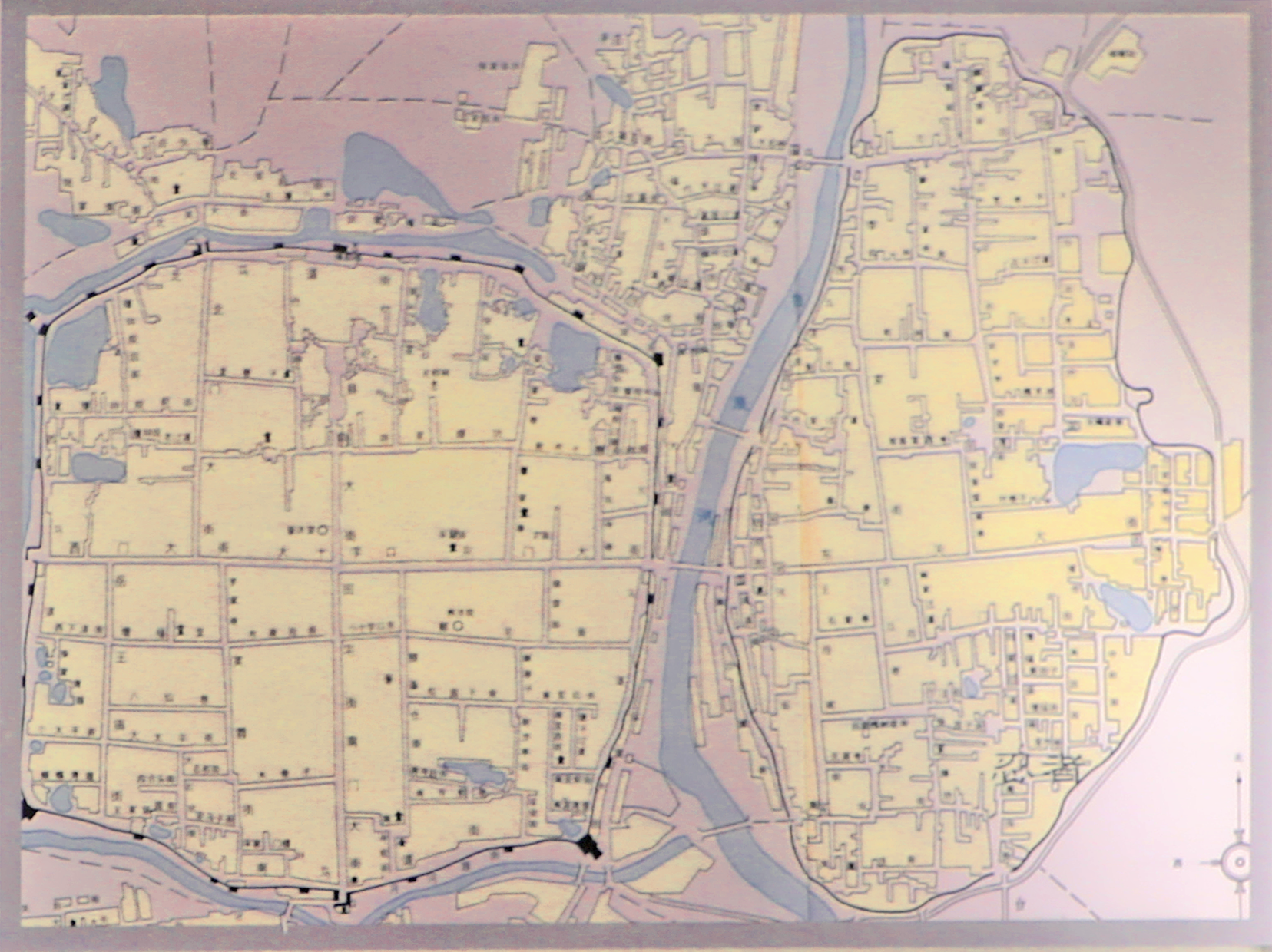
WEIHSIEN IN THE GREAT HISTORY
After the abolition of the sea ban in the late Qing Dynasty, Weihsien became one of the self-opening commercial ports.
Since then, its machine manufacturing, dyeing and weaving, pigment chemical industry, iron processing and other industries had developed rapidly and there emerged a large number of businesses, which were well-known in the whole province and even the whole country.
On the other hand, the Germans built the Jiaozhou-Jinan Railway in Shandong Province, which changed the economic pattern of Shandong Peninsula. It started from Jinan in the west to Qingdao in the east. With the transportation power of trains, many towns along the Jiaozhou-Jinan Railway line were more prosperous.
Weihsien which was an important commodity distribution center had also gained new development opportunities because of this railway and became an important commercial port in central Shandong. A large number or import and export goods gathered here, which were transported to the hinterland of Shandong or to Qingdao and then shipped out.
WEIHSIEN IN THE LATE QING DYNASTY AND THE EARLY REPUBLIC OF CHINA
When Weihsien people are asked about the ancient city, most of them will mention the "Tortoise city and Snake city". Tortoise city means the county town, also known as the main city or the west city. There are four gates in the city, outside three of which are built with "small town". The whole city is like a lying tortoise, so it got the name of Tortoise city. When you go out of the east gate and cross the moat, you will see the Dongguan dock. In the Yuan Dynasty, businessmen lived by the river and market transactions gradually developed. Since then, the Ming Dynasty built walls around it and then formed the east City. Because the dock wall of the east city is built along the river, the city is winding and tortuous, like a snake, which contrasts with the main city. As a result, there are two cities in Weihsien and both of them rely on each other.
THE INDUSTRIAL DEVELOPMENT OF WEIHSIEN
The industrial development in modern China is full of difficulties and humiliation.
Weihsien is an example.
Since the late Qing Dynasty and the Republic of China, foreign capitalists came here and built factories, which promoted the industrial development of the city. Many national industrialists also took the spirit of "saving the nation by engaging in industry" and joined in the industrialized development of the city. They used the advanced technology and management of the West, and set up the first modern enterprises.
By the beginning of the Republic of China, Weihsien has entered the "the primary stage of industrialization", and the local machine manufacturing industry remained closely allied with those of Qingdao, Tianjin, Beiping (now Beijing) and other major cities.
FANGZI TOWN
In 1900, the German prospecting team discovered coal seams with total reserves of 3 to 3.5 million tons in the southeast of Weihsien. In the following year, the first coal well was drilled here, which marked the beginning of Weifang Fangzi District today.
After the opening of Jiaozhou-Jinan Railway, the Germans began to plunder the resources of Fangzi Coal Mine, which lasted for 17 years. After the First World War, Japan occupied the huge mineral and exploited it for 30 years. According to statistics, during the 40 years of Germany and Japan occupation, more than 4 million tons of coal were plundered. These invaders left behind a large number of colonial buildings, and nearly 200 are still in good condition, including consulate, hospitals, train stations, locomotive repair sectors, telegraph buildings, post offices, churches, schools, command barracks, water stations, senior officer's residential areas, and the like.
WEIHSIEN STATION
Weihsien is an important node on Jiaozhou-Jinan Railway. The picture shows the old Weihsien Station, which has just been built and put into use at the beginning of the 20th century. Its external walls and dormer windows are obviously German style, and the roof adopts Chinese cross ridge, tube tile and carves with rigid beast. The mixture of architectural style precisely reflects the collision and integration of Chinese and Western cultures at that time. Perhaps the German architect deliberately mix in the Chinese elements, or compromise to the aesthetic taste of the local gentry.
INCIPIENT MODERN INDUSTRY
These group of pictures reflects the Weihsien national industry in the 1930s. In the early days, Weihsien's industry was greatly affected by foreign countries. For example, in 1917, the British tobacco factory built a factory in Ershilipu, Weihsien. The earliest and largest tobacco factory in China had, to some extent, contributed to the development of Weihsien tobacco industry. Later, Weihsien gradually formed its own national industry.
THE WEDGING OF WESTERN CULTURE
In 1882, the ancient Weihsien welcomed two Westerners who bought a vast tract of land in the suburbs. In the following year, the plaque reading “Le Dao Yuan” was hung up. The establishment of the Courtyard was like a harsh interposition of a miniature modern society into the traditional society of Weihsien, causing a great disturbance. Weihsien people talked about the Courtyard, which was established by foreigners and equipped with a church, a new-style school and a hospital. No matter what they said, it existed. Though it did not survive the intense cultural conflict that took place in the Gengzi year (1900), it was rebuilt after things calmed down and took root in Weihsien.
It is undeniable that the Courtyard was forcibly inserted into the land of Weihsien. When it collided with traditional Chinese culture, it did break China’s independence. However, it also promoted the development of Weihsien. Influenced by Western culture, Weihsien people began to explore the world actively and fought courageously in the modernisation of China.
THE BUILDINGS IN THE COURTYARD OF THE HAPPY WAY
As early as 1866, Calvin Wilson Mateer, an American missionary who had been in China for three years, and his companion Hunter Corbett went from Dengzhou (now Penglai) to Jinan by train. When they passed Weihsien, they found it was a prosperous city. At that time, Calvin Wilson Mateer was determined to build a church here and to preach. A few years later, he came to Weihsien again. Li Shiyuan (a native of Weihsien, who was doing business in Yantai at that time) helped him to inspect Weihsien. However, his idea was not put into practice.
In 1881, Calvin Wilson Mateer's younger brother, Robert M. Mateer, arrived in Dengzhou. Before sailing across the sea to China, this young man had just graduated from Princeton Theological Seminary in the United States. Under the care of his brother, he studied Chinese for a few days and learned some Chinese culture, and then he set out with his wife for Weihsien. Along him were minister John Hood Laughlin, Doctor Ming and other people. When they first arrived in Weihsien, they temporarily lived at Li Shiyuan's house. One day, when he went to Lijiazhuang in the south of the city to visit Li Fanggui, who had graduated from Dengzhou Wenhui Academy, he saw the beautiful scenery of the area. So with the help of Li Fangling (a member of Christian Presbyterian Church of the Courtyard of the Happy Way), the brother of Li Fanggui, he bought a land and built the Courtyard of the Happy Way.
THE BEGINNING OF ITS ESTABLISHMENT
Picture introduction: Robert M. Mateer bought 16.5 mu of land in the northwest of Lijiazhuang to the south of Yuhe River. One year later, the Courtyard of the Happy Way, which was composed of bungalow and covered an area of 11000 square meters, had been initially built. The whole building area could be divided into three parts: school, clinic and church. At the beginning, Robert M. Mateer and his wife managed the specific affairs, mainly preaching, by themselves.
When the Courtyard of the Happy Way was first built, few people came here. There were few households around and even Lijiazhuaiig, the nearest place was more than 1 li away (1 li = 0.5 kilometers) and the road was rough.
So few Chinese would come to "this remote temple run by foreigners".
Robert M. Mateer and other missionaries had to change the way of sermon, and expanded the influence of the church through secular undertakings such as schools and hospitals.
BUILDINGS IN THE COURTYARD OF THE HAPPY WAY
Since 1882 when American missionary Robert M. Mateer built the first house of the Courtyard of the Happy Way, there have been many different types of buildings. Compared with that of Nanjing and Shanghai at that time, the construction of the Courtyard of the Happy Way is much smaller, but has its own characteristics. For example, the "cross building", which has been preserved until today, is particularly unique in its cross-shaped building structure. And the former church of the Courtyard of the Happy way looks like a complex and exquisite Chinese pavilion. Although the building of these modern buildings results from the introduction of foreign church forces, it has greatly changed the city and witnesses the social development in modern times.
CORNERSTONE
The cornerstone shows the age and function of the cross building: 1924, hospital.
CROSS TYPE
There is usually a paradigm in the structure of European architecture, such as "L" shape and "H" shape, which may be commonly seen in palaces or houses. The "shape" of the cross building is very rare, and experts speculate that it is likely to be related to religion.
VERTICAL SLIDING WINDOW
Vertical sliding window is the characteristic of American architecture, which is featured by good sealing and not easy to fall. There is a special structure on the window frame, so that the window sash can stay in different positions.
DORMER WINDOW
The skylight on the slope roof, like a tiger stretching its head out of the roof, is a typical feature of Western architecture.
GANGED BRICK
The outer wall of the cross building is made of gray ganged bricks. It is said that all the grey bricks were shipped from the United States all the way, presumably because of the poor quality of the local tiles at the time.
HEART OF THE CHURCH
After 1860, the western churches began to enter Shandong on a large scale, and the missionaries set up the church in Weihsien and surrounding areas, such as the city of Yidu, Linyi, Changyi, and so on. Taking the church as the stronghold, they sermonized, preached and won converts. Weihsien, because of its favorable location, became the center of the whole area.
Since Robert M. Mateer established the Courtyard of the Happy Way, it had become a local missionary center and the most important religious activity base of the west church. After that, the Germans constructed the " Jiaozhou-Jinan Railway ", and the traffic lines between the cities of Shandong were more dense and convenient. The Courtyard of the Happy Way had also been a Christian communication center in the area of Changyi and Weihsien, ruling more than 10 parishes, such as Weihsien, Changle and Anqiu. Most of the parishes had built churches and had full-time priest.
After the western church entered Shandong, it actively carried out missionary activities, and with the efforts of the missionaries, an extensive preaching network was established and organised in cities of Shandong . According to the data, in 1931, Nanguan Church became the Catholic Tudor Cathedral in Weihsien, administering Masu Church, East Jinmazhuang Church, Miaobu Church, Xingbu Church, Qingchi Church and Fangzi Church. At the same time, it was also responsible for the management of affairs in Changyi and areas around Nanliu, Anqiu.
DIFFICULTIES AND TRIBULATION
In June 1900, the "anti-foreign religion" movement spread to Weihsien, where the people besieged the Courtyard of the Happy Way and burned it. In 1902, with reparations from the Qing government, donation of U.S. government from Boxer Indemnity and donation from American Church, another 160 mu of land were purchased to build and expand the Courtyard of the Happy Way. In 1904, the rebuilt was basically completed and the area was expanded to more than 200 mu, stretching to the main road that linked Li Jiazhuang and the south gate of Dongguan in the south bank of Yuhe river in the north.
After the Courtyard of the Happy Way was burned, under the charge of the church, the Qing government arrested Chen Xiqing and others. After negociation, the Qing government would pay 50,000 teals of silver to reconstruct it. When Robert M. Mateer returned from Ynatai in which he soughed refuge, he decided to expand and reconstruct the Courtyard of the Happy Way and expand the clinic into a hospital. The entire expansion project cost more than 400,000 taels of silver, some of which came from the "Boxer indemnity" (100,000 teals of silver was invested in the Couryard of the Happy Way), and the rest came mainly from donations from the American church ($26,125.00).
RECONSTRUCTION OF THE COURTYARD OF THE HAPPY WAY
When the Boxer movement ended, Robert M. Mateer and his wife, and other 16 people, went from Yantai to the Yangjiaogou, Shouguang County, which was located in the estuary of Xiaoqing River, by boat .
Yuan Shikai. the governor of Shandong Province, had sent troops to welcome them and escorted them back to Weihsien .
The Courtyard of the Happy Way had been burned into rubble, and they had nowhere to settle. Then Local officials arranged them to live in the hotel temporarily.
Yuan Shikai also made a special call from Jinan and ordered the local officials to send a present for him (In the picture is the fat sheep that Yuan Shikai sent to the missionaries), and to set up a banquet to welcome them. The magistrate didn't dare to decide how to deal with the burned Courtyard without authorization, and after asking Yuan Shikai, he began to discus reconstruction with Robert M. Mateer and others.
After reconstruction, the Courtyard of the Happy Way expanded its area to 200 mu with a large scale and different building tykes. Robert M. Mateer and others realized the importance of the gentry class in promoting the missionary cause, and they began to woo them.
In 1916, the anti-Yuan war spread to Weihsien, and the Courtyard of the Happy Way became a refuge for wealthy families. After the war, the gentry in the city was very grateful for its assistance. The made a special plaque for it with four characters of "Loving people. Caring neighbors" on it.
THE PLACE FOR TRUTH
Weihsien (now Weifang), located in the hinterland of the states of Qi and Lu, had formed an atmosphere of academy since ancient times. Reading books related to Confucius and Mencius, and taking the imperial examination were the right way to follow in the minds of Weihsien people. When Westerners came far away and stopped in Weihsien, which was deeply influenced by Confucian morality, they found that education was the root of the land. If they wanted to put foreign ideas into the lives of Weihsien people, preaching was not feasible. As a result, the new school was set up, first only for boys, and then for girls.
Modern Chinese were strangers to subjects in foreign schools, such as mathematics, physics, chemistry, natural science and others. So at first, there were very few students. However, history was moving forward, and the impact of science was enormous. Because of contact, study and absorption of advanced knowledge, many people in Weihsien could open their eyes and see the real world. After getting rid of "ignorance", they would contribute their own strength to build a modern China.
SCHOOL LIFE
Guangwen Middle School selected and recruited outstanding graduates from Chefoo University and other famous universities, and experienced, competent and famous teachers, paying close attention the quality of teaching. The school attached great importance to the cultivation of public moral, so it established the principle of moral, intellectual, physical and collective education, and combining learning and use. And it formulated the school motto of "mutual assistance service and sacrifice". In view of the tense situation in North China, Guangwen Middle School has also added military training courses to strengthening students' body.
FAMOUS UNIVERSITIES IN THE LAND
As the Boxer Rebellion swept the land of North China in the early 20th century, many Western church buildings, including the Courtyard of the Happy Way, were burned down. When the war ended, missionaries rethought the nature, role and status of church schools. They believed that it was necessary to establish institutions of higher learning in China to promote the development of religion.
In June 1902, Qingdao was opened: up as a commercial port, and the Jiaozhou-Jinan Railway was completed and opened to traffic. Weihsien was located in the center of Jiaozhou-Jinan Railway, which had great development prospects. As a result, the Presbyterian Church (North) of America and the British Baptist Church decided to merge the Dengzhou Wenhui Academy and the Qingzhou Guangde Academy, moved the university departments of the two schools to the Courtyard of the Happy Way, and named it "Guangwen University ". Whether Wenhui Academy or Guangwen University, its teachers and equipment at that time were first-class in the country. There were such subjects as literature, science, industry and chemistry. Complete equipment, experimental factories, plus excellent teachers and students created a lot of first-class talent for China.
GUANGWEN UNIVERSITY
In l904, the Wenhui Academy founded by the American missionary Calvin Wilson Mateer, was moved to Weihsien and merged with the Guangde Academy run by the British baptist church in Qingzhou. The new school was situated in the Courtyard of the Happy Way with the name of Guangwen School (later renamed Guangwen University).
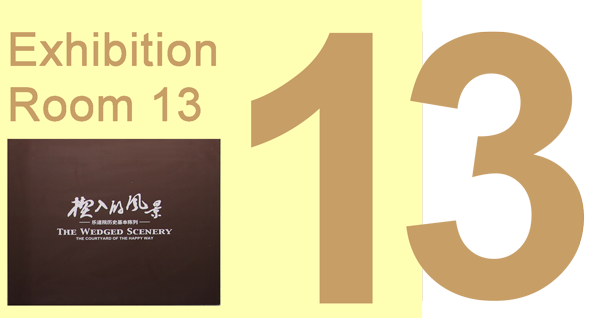
RESTORATION OF AN ART CLASSROOM
Education took a large proportion of the development of the Courtyard. Back then, all kinds of subjects were taught here, including art. This is a restoration of an art classroom at that time. Students would see and learn to appreciate beauty here, and then graduate from the Courtyard, leave Weihsien and explore the outside world…
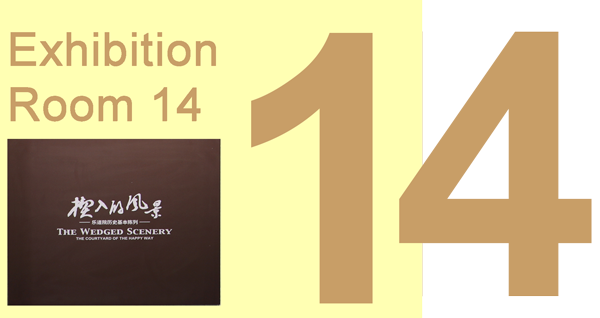
RESTORATION OF AN ART CLASSROOM
This is a special classroom. Stepping in it, we will feel as if we went back in time. Glass is used as a tool here to separate the past and the present. The scene on the other side of the glass is restored according to old photos of that time. Every detail is arranged according to history. When we sit on the bench on this side of the glass, we will find that our images are reflected in the historical scene.
THE SPREADING OF HUMANITY
Whether in the East or the West, religion is thought it to be a virtue to help others. When missionaries crossed the sea to China, they also brought the modernizing western medical concept to this ancient country. It was the late Qing Dynasty, and the society was unrest.
Foreign doctors tried their best to treat the Chinese patient. In that white place of peace, there was no skin color, race, religion, nationality, but only doctors and patients. It way this kind of kindness that resolved the sharp contradiction between the two civilizations.
The medical modernization of Weihsien also started from the Courtyard of the Happy Way. The initial clinic, because of the increase in demand, gradually expanded into a large hospital which was rare in Shandong Province. Since then, surge X-ray. infusion, which were regarded as the advanced surgery, internal medicine examination, diagnosis and treatment methods at that time, rooted in this city and remained alive today with the development of modern medicine in Weihsien.
Chronicle of the Medical Events at the
Courtyard of the Happy Way
1882-1949
1882
Mateer Robert M bought 5.5 mu of land in
Jiazhuang (Li Village) to the southeast of
Weihsien to build the Courtyard of the Happy Way.
1883
The construction of the Courtyard of the Happy Way completed, establishing a building complex that integrated church, school and clinic.
1900
During the Boxer Rebellion, the Courtyard of the
Happy Way was set on fire by rioters in Weihsien, with 42 multiple-storey houses and 136 one-storey houses burnt down, and the clinic was destroyed.
1902
The reconstruction of the Courtyard of the I lappy Way started.
1904
The reconstruction of the Courtyard of the Happy
Way completed. The clinic was expanded into a
hospital with separate treatment areas for men and
women. The hospital was then called Weihsien Shantung
American Presbyterian Hospital.
1916
The Surgical Department performed 152 surgical operations for inpatients.
1918
The hospital offered 298 days of outpatient service. The Inpatient Department had 40 beds, and received and cured 403 inpatients. 501 surgical operations were performed.
1925
The "Cross Building" was constructed and the hospital was renamed as Weihsien Christian Hospital.
1939
A total of 1,255 patients were received and cured.
1941
The Pacific War broke out. The hospital was occupied by the Japanese Army, and the outpatient service was closed.
1942
The Japanese Army turned the Courtyard of the Happy Way into a concentration camp.
1946
After the victory of the Anti-Japanese War, the hospital re-opened after preparation.
1949
After the foundation of People' s Republic of China. the hospital was renamed as Weifang Cortyard of the Happy Way Hospital.
When the courtyard of the Happy Way was first built, only some Chinese people could work in nursing care, and all the doctors were foreigners. In 1913, the hospital gradually had Chinese doctors, such as Yang Xiushan, Luv Youqing, Zhang Tongxin, Zhang Xuejian, Han Bingnan, and so on. However, for religious reasons, both doctors and nursing staff are church members. in addition, the medical level of hospitals was also improving increasingly. According to records, by 1918, such operations could be performed as cataract extraction, total eyeball extirpation, amputation, fetal shredding, sternoctomy, breast cancer resection, esophageal stenosis dilatation, iridectomy, breast sinus surgery and so can in the hospital
The hospital was an important part of the Courtyard of the Happy Way. When Robert M. Mateer came to Weihsien, two doctors were with him: the male doctor was William Hong, and the female doctor was Madge Dickinson. The history of the Hospital in the Courtyard of the Happy Way can be roughly divided into three periods: The period before Boxer indemnity (1901) was the early stage of the establishment of the hospital. During this period. the hospital had fewer personnel and poor equipment, and its size \V as slightly the same as that of the clinic. The period from 1900 to 1924 was the development stage of the hospital. During this period, the Outpatient Department is still the main business, while the simple wards had been gradually added, and some patients could he hospitalized. In this period, male and female clinics were separated. The period after the completion of the ward building (cross building) in 1925 was the third stage for the development of the hospital. With complete medical facilities, the hospital had become a large-scale and high-grade comprehensive hospital in Jiaodong at that time.
HISTORY CANNOT BE FORGOTTEN
Although the hospital had made great progress through reconstruction after Siege of the International Legations, the hospital conditions were still very poor. At that time, the inpatient wards of the hospital were generally low house with insufficient light and poor ventilation, and there were only 40 beds. Although the beds could be increased to 70 in peak hours, each ward had two beds, which was very crowded for patients.
In order to meet the needs of patients. American doctor E. E. Murray was determined to expand the size of the hospital. In 1923, Dr. Murray backed to the United States to raise funds for the expansion. In the following year, construction of the hospital building began and was presided over by a Chinese Zhang Tongxin (Zhang Zhifu). The building had four floors and its construction area was 2461 square meters. Because the building was a "cross" shape, so it was called as the "cross building".
In 1925, when the building was completed, the Hospital in the Courtyard of the Happy Way held an inauguration ceremony to celebrate it and renamed it as Weihsien Christian Hospital. More than a hundred celebrities came to congratulate and took photos to mark the occasion. It could accommodate 120 beds and had heating system, X-ray room, laboratory and well-equipped operating room with over 80 personnel. And it had become a large-scale and high-grade hospital around the area of Jiaodong and the number of patients coming from far and near had increased day by day.
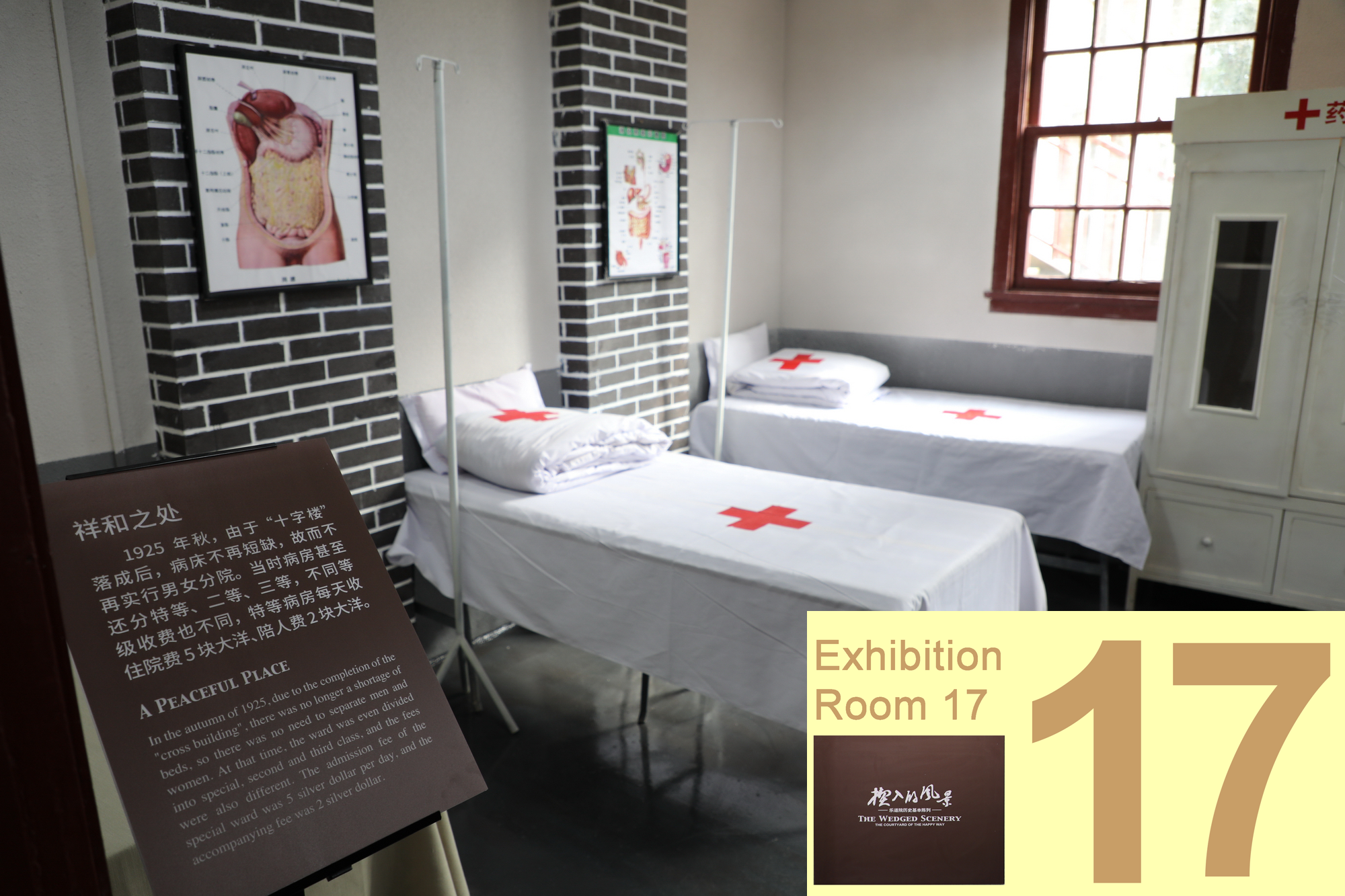
PLACE OF HARMONY
In the autumn of 1925, the “Cross Building” was built, and the hospital was no longer short of beds. So, male and female patients were no longer separated in different buildings. At that time, the inpatient wards were even divided into different levels with different charges.
A top-level ward cost five silver dollars of hospitalisation fee and two silver dollars of nursing fee.
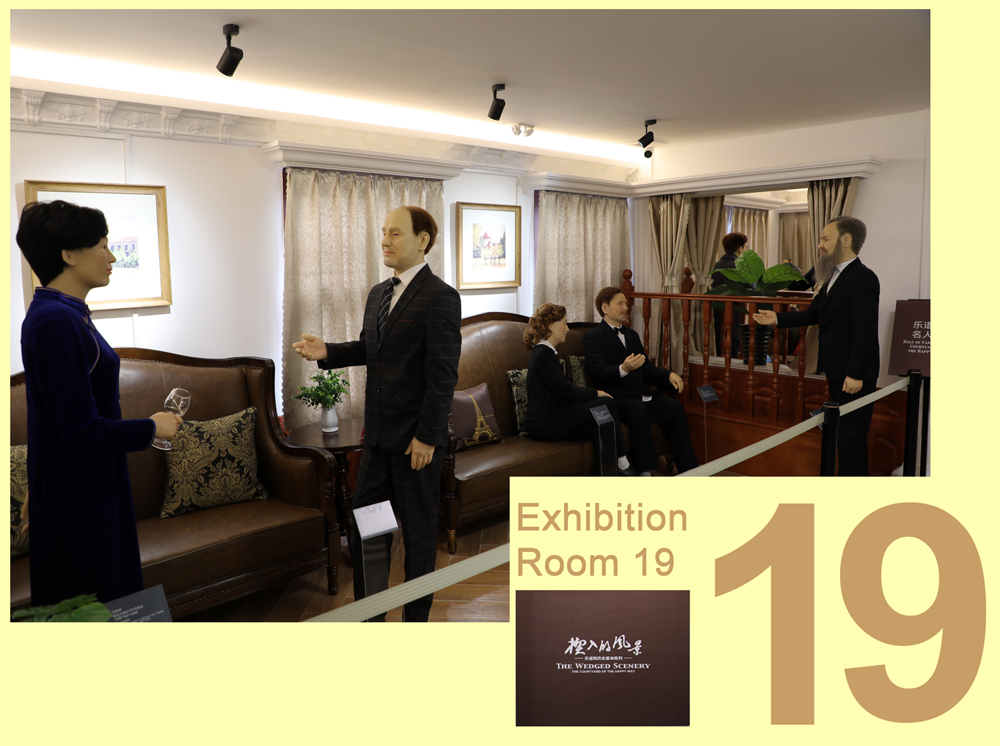
Hall of Fame
Exhibition Room 19,
An old generation of American educators who left their families, left behind their careers overseas and came to China is introduced in this Hall of Fame of the Courtyard. They endured great hardships and initiated the cause of education in China, playing an important role in the modernization of traditional, feudal Chinese education. In the meantime, they were witnesses of the cultural exchanges between China and the West. They devoted their life and all they had to establishing schools in China and promoting Sino-American friendship.
PEOPLE WHO MADE MACHINES
Under the reign of Emperor Tongzhi of the Qing Dynasty, the Self-Strengthening group started to carry out an educational reform, which was the result of over 20 years of discussion after the Opium War. It required the cultivation of talents of both Chinese and Western learning, in order to master the “method of making machines” and develop “people who made machines”. China would only be competitive when it had talented people in foreign language, industrial technology and military affairs. Represented by the Courtyard of the Happy Way, institutions established by Western missionaries had a profound influence on the transformation and development of education in modern China.
Those Chinese people who graduated from the Courtyard or worked at the hospital expanded their vision through the school and working experience. They accepted new things and their minds got liberated. They grew up rapidly and became the backbone force of Weihsien. We can say that they were the outstanding representatives of the intellectuals in modern Weihsien and the new driving force for Weihsien to change itself.
Zhang Tongxin, alias Zhang Zhifu, was a famous doctor and a native of Weihsien. He graduated from Medical College of Cheeloo University in 1914. In the same year, he was admitted to the Hospital in the Courtyard of the Happy Way as a physician, and then promoted to attending physician and dean. After the War of Resistance against Japan, he was appointed Honorary President and Director of the Board of Directors of Qingdao Lutheran Church Hospital. After the founding of the people's Republic of China, Lutheran Church Hospital was renamed Qingdao Hospital and he still served as President.
Yin Huanzhai, a native of Weihsien, graduated from Guangwen University. In 1925, Ralph C. Wells, the former president of Wenhua Middle School, was transferred to Shanghai and replaced by him. In 1931, Wenhua Middle School, Wenmei Girls' Middle School and Peiji Primary School merged to Guangwen Middle School, and Yin Huanzhai left. Yin Huanzhai was a famous industrialist in Weihsien. He founded Xinfeng Printing Ltd., which ranked top in Shandong printing and dyeing industry at that time, and co-founded Huafeng Machinery Factory with Teng Huchen.
Xu Huanzi, who studied at Yenching University, was invited to Weihsien as president of Wenmei Girls' Middle School in 1927. She was the third principal of the school and her office term ended in 1930. During her tenure as principal, she funded some progressive youth to find and join the Communist Party of China.
Cui Derun, born in 1902, was a native of Weihsien, Shandong Province. After graduating from primary school in 1914, he was admitted to Wenhua School in the Courtyard of the Happy Way and Kvas admitted to School of Arts and Sciences of Cheeloo University in 1919. After graduation, he stayed in school and became a teaching assistant. After the establishment of Guangwen Middle School, Cui Derun was elected by the school board of directors to serve as president.
WE HAVE NOT FORGOTTEN
Since the late Qing dynasty, many western missionaries had come to China. At first they were just preaching, but in the process of preaching, they had gradually spread modern knowledge to the Chinese, thus promoting the modernization of the country. They should not be forgotten.
Calvin Wilson Mateer, born in Pennsylvania. America, was a missionary of Presbyterian Church in the United States of America, a modern educator, a translator, a philanthropist, and pioneer of modern Chinese science education.
He came to China at the end of 1863 and preached in Dengzhou, Shandong Province and set up Wenhui Academy there.
In 1904, the Academy moved to Weihsien and merged with the Guangde Academy, which was run by the British Baptist Church in Qingzhou, and the new school was called Guangwen School (later Guangwen University). After working on education in China for decades, he had always advocated the wide dissemination of western science and culture in order to promote China's progress.
In 1908. this educator who had lived in Shandong for decades passed away in Qingdao.
Robert M. Mateer was the brother of Calvin Wilson Mateer.
He graduated from the Seminary at Princeton University in 1881. At the end of the year, he came to China.
With the assistance of local church friends in Weihsien, he then set up the Courtyard of the Happy Way to preach and sermon, develop education and open clinics. He had preached in China for nearly 40 years and died in Weihsien on September 5. 1921.
He devoted his whole life to China.
Madge Dickinson, the wife of Robert M. Mateer, was president of Wenmei Girls' Middle School and hospital physician. She was in charge of the church affairs after Robert M. Mateer died.
The Extensive, Wise Courtyard of the Happy Way
The Courtyard of the Happy Way was not alone. There were multiple institutions like the Courtyard in modern Shandong, such as Wen Hui Guan. The Courtyard is important for the research on Christianity’s influence on education and medicine in Weihsien, Shandong and even the whole country in modern times. It witnessed the Sino-Western cultural exchanges in modern and contemporary times. Its development history is the epitome of the social changes in Weihsien.
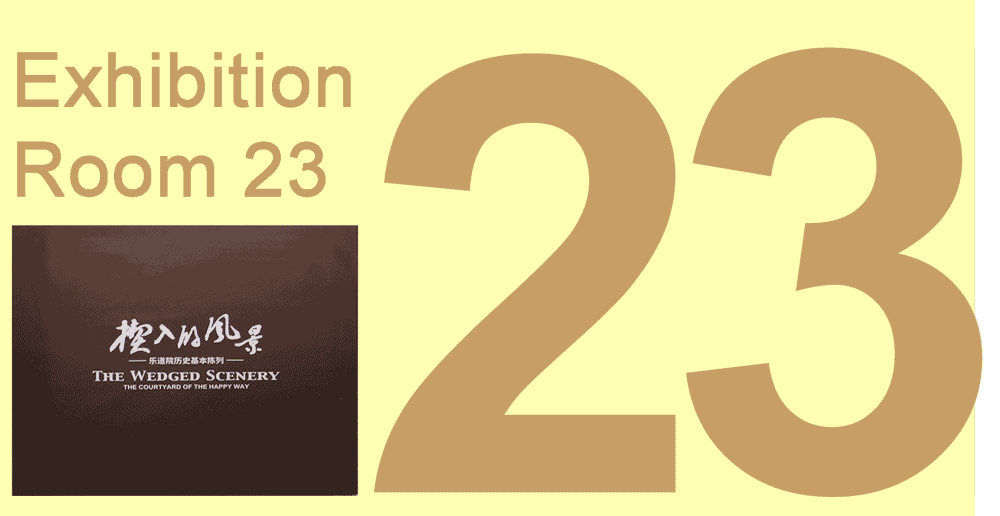
MERITS AND DRAWBACKS
The Courtyard of the Happy Way was a communication base of Western religions in Weihsien. Its emergence and development were inseparable from the social environment at that time. Its establishment was ground-breaking in many aspects in Weihsien. The Courtyard promoted the modern reforms in Weihsien, cultivated a large number of talents for Weihsien and played a significant role in the transformation of social customs, establishment of new education, medical and health services, as well as social reforms in Weihsien.

EPILOGUE
More than 130 years ago, Western missionaries set up the Courtyard of the Happy Way in Weihsien. This building complex that integrated school, hospital and church was thus embedded in the land of traditional China, witnessing the vicissitudes in the late Qing Dynasty and the Republic of China period together with the city walls and lofty watchtowers in the distance.
The interposed Courtyard of the Happy Way was once rejected by Weihsien people, but they soon followed the way of “meeting practical needs” and devoted to practising the famous Chinese proposition of “learning from the West”. After absorbing nutrition from modern civilisation, the Courtyard promoted modernisation in China. The Courtyard of the Happy Way, guided by the Cross, changed Weihsien in a special way and promoted social progress in China to some extent.



